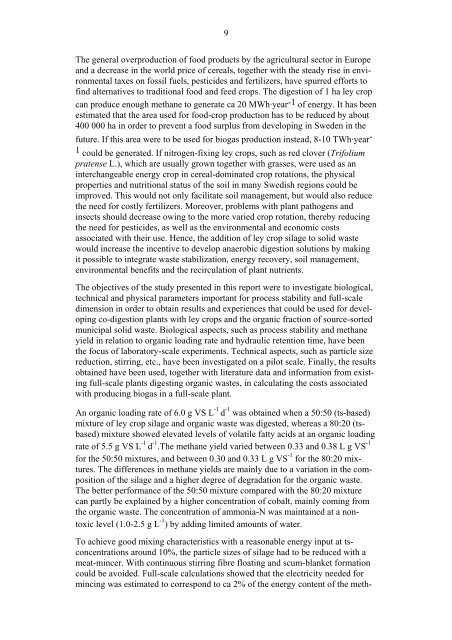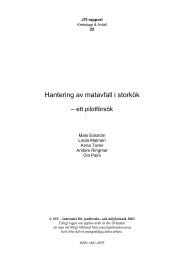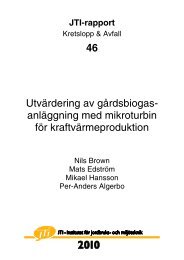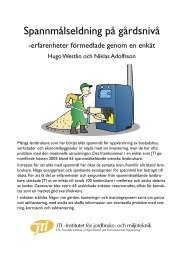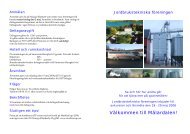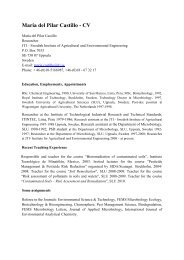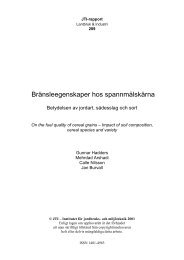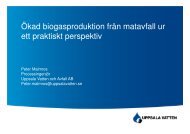You also want an ePaper? Increase the reach of your titles
YUMPU automatically turns print PDFs into web optimized ePapers that Google loves.
9<br />
The ge<strong>ner</strong>al overproduction of food products by the agricultural sector in Europe<br />
and a decrease in the world price of cereals, together with the steady rise in environmental<br />
taxes on fossil fuels, pesticides and fertilizers, have spurred efforts to<br />
find alternatives to traditional food and feed crops. The digestion of 1 ha ley crop<br />
can produce enough methane to ge<strong>ner</strong>ate ca 20 MWh·year -1 of e<strong>ner</strong>gy. It has been<br />
estimated that the area used for food-crop production has to be reduced by about<br />
400 000 ha in order to prevent a food surplus from developing in Sweden in the<br />
future. If this area were to be used for biogas production instead, 8-10 TWh·year -<br />
1 could be ge<strong>ner</strong>ated. If nitrogen-fixing ley crops, such as red clover (Trifolium<br />
pratense L.), which are usually grown together with grasses, were used as an<br />
interchangeable e<strong>ner</strong>gy crop in cereal-dominated crop rotations, the physical<br />
properties and nutritional status of the soil in many Swedish regions could be<br />
improved. This would not only facilitate soil management, but would also reduce<br />
the need for costly fertilizers. Moreover, problems with plant pathogens and<br />
insects should decrease owing to the more varied crop rotation, thereby reducing<br />
the need for pesticides, as well as the environmental and economic costs<br />
associated with their use. Hence, the addition of ley crop silage to solid waste<br />
would increase the incentive to develop anaerobic digestion solutions by making<br />
it possible to integrate waste stabilization, e<strong>ner</strong>gy recovery, soil management,<br />
environmental benefits and the recirculation of plant nutrients.<br />
The objectives of the study presented in this report were to investigate biological,<br />
technical and physical parameters important for process stability and full-scale<br />
dimension in order to obtain results and experiences that could be used for developing<br />
co-digestion plants with ley crops and the organic fraction of source-sorted<br />
municipal solid waste. Biological aspects, such as process stability and methane<br />
yield in relation to organic loading rate and hydraulic retention time, have been<br />
the focus of laboratory-scale experiments. Technical aspects, such as particle size<br />
reduction, stirring, etc., have been investigated on a pilot scale. Finally, the results<br />
obtained have been used, together with literature data and information from existing<br />
full-scale plants digesting organic wastes, in calculating the costs associated<br />
with producing biogas in a full-scale plant.<br />
An organic loading rate of 6.0 g VS L -1 d -1 was obtained when a 50:50 (ts-based)<br />
mixture of ley crop silage and organic waste was digested, whereas a 80:20 (tsbased)<br />
mixture showed elevated levels of volatile fatty acids at an organic loading<br />
rate of 5.5 g VS L -1 d -1 .The methane yield varied between 0.33 and 0.38 L g VS -1<br />
for the 50:50 mixtures, and between 0.30 and 0.33 L g VS -1 for the 80:20 mixtures.<br />
The differences in methane yields are mainly due to a variation in the composition<br />
of the silage and a higher degree of degradation for the organic waste.<br />
The better performance of the 50:50 mixture compared with the 80:20 mixture<br />
can partly be explained by a higher concentration of cobalt, mainly coming from<br />
the organic waste. The concentration of ammonia-N was maintained at a nontoxic<br />
level (1.0-2.5 g L -1 ) by adding limited amounts of water.<br />
To achieve good mixing characteristics with a reasonable e<strong>ner</strong>gy input at tsconcentrations<br />
around 10%, the particle sizes of silage had to be reduced with a<br />
meat-mincer. With continuous stirring fibre floating and scum-blanket formation<br />
could be avoided. Full-scale calculations showed that the electricity needed for<br />
mincing was estimated to correspond to ca 2% of the e<strong>ner</strong>gy content of the meth-


